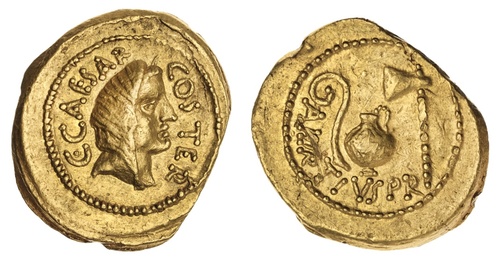
Auction: 23004 - Ancient and British Coins - Featuring the 'White Rose' Collection
Lot: 635
Roman Imperatorial, Julius Caesar, with Aulus Hirtius, as Praetor, 'Quadruple Triumph', AV Aureus, struck 46 BC, Rome,
Provenance
Sir John Evans, Rollin & Feuardent (Drouot), 26-27 May 1909, lot 5* - 'FDC' - 82 Francs
Authorised by Caesar himself, the present coin was part of the first ever large-scale issue of gold specie in the history of t Roman Republican coinage. Under extreme pressure to strike the vast quantities of coinage that Caesar required in time for his 'Quadruple Triumph' and the return of his veteran soldiers to Rome, the exacting standards of the Capitoline mint slipped drastically.
The 'Quadruple Triumph' that Caesar celebrated on his return to Rome in 46 BC was spread over four days, with each day to feature a themed procession commemorating his four greatest achievements on campaign: the victories in Gaul while he was proconsul between 58 and 51 BC, his defeat of Ptolemy XIII of Egypt in 47, of Pharnaces of Pontus later the same year and finally over king Juba of Numidia. Juba was cast as the main enemy of the recently successful African campaign, for a Triumph could not be celebrated for the defeat of fellow Romans, a fact that left many uneasy due to the common knowledge of the deaths of Scipio and Cato, Caesar's real opponents.
It is also interesting to note that the types chosen by Caesar to mark his attainment of military supremacy could not have been more opposite to the character of the occasion for which they were intended for. Referencing Caesar's occupation of various religious positions with the emblems of the augurate and pontificate on the reverse, it is believed Caesar sought to highlight his care for Rome, the family and home by honouring Vesta, goddess of the hearth, with the veiled female head on the obverse. Although never positively identified as Vesta, that her rites were under the care of the pontifices, and most especially Caesar himself as Pontifex Maximus, makes this likely a correct assumption.
Subject to 20% VAT on Buyer’s Premium. For more information please view Terms and Conditions for Buyers.
Sold for
£13,000
Starting price
£5000




